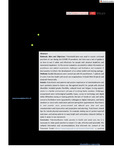Telerehabilitation for physical disabilities and movement impairment: A service evaluation in South West England
| dc.contributor.author | Buckingham, SA | |
| dc.contributor.author | Sein, K | |
| dc.contributor.author | Anil, Krithika | |
| dc.contributor.author | Demain, S | |
| dc.contributor.author | Gunn, Hilary | |
| dc.contributor.author | Jones, Ray | |
| dc.contributor.author | Kent, B | |
| dc.contributor.author | Logan, A | |
| dc.contributor.author | Marsden, Jonathan | |
| dc.contributor.author | Playford, ED | |
| dc.contributor.author | Freeman, Jennifer | |
| dc.date.accessioned | 2022-04-29T11:57:32Z | |
| dc.date.issued | 2022-04-19 | |
| dc.identifier.issn | 1356-1294 | |
| dc.identifier.issn | 1365-2753 | |
| dc.identifier.uri | http://hdl.handle.net/10026.1/19125 | |
| dc.description.abstract |
<jats:title>Abstract</jats:title><jats:sec><jats:title>Rationale, Aims and Objectives</jats:title><jats:p>Telerehabilitation was used to ensure continued provision of care during the COVID‐19 pandemic, but there was a lack of guidance on how to use it safely and effectively for people with physical disabilities and movement impairment. In this service evaluation, we aimed to collate information on practitioner and patient experiences, challenges and facilitators, and examples of best practice to inform the development of an online toolkit and training package.</jats:p></jats:sec><jats:sec><jats:title>Methods</jats:title><jats:p>Guided discussions were carried out with 44 practitioners, 7 patients and 2 carers from five health and social care organisations in South West England, and analysed thematically.</jats:p></jats:sec><jats:sec><jats:title>Results</jats:title><jats:p>Practitioners and patients had positive experiences of telerehabilitation and were optimistic about its future use. Recognized benefits for people with physical disabilities included greater flexibility, reduced travel and fatigue, having appointments in a familiar environment and ease of involving family members. Challenges encountered were: technological (usability issues, access to technology and digital skills); difficulties seeing or hearing patients; the lack of ‘hands‐on’ care; and safety concerns. Facilitators were supported by colleagues or digital champions, and family members or carers who could assist patients during their appointments. Key themes in best practice were: person‐centred and tailored care; clear and open communication and observation and preparation and planning. Practitioners shared tips for remote physical assessments; for example, making use of patient‐reported outcomes, and asking patients to wear bright and contrasting coloured clothing to make it easier to see movement.</jats:p></jats:sec><jats:sec><jats:title>Conclusion</jats:title><jats:p>Telerehabilitation holds promise in health and social care, but it is necessary to share good practice to ensure it is safe, effective and accessible. We collated information and recommendations that informed the content of the Telerehab Toolkit (<jats:ext-link xmlns:xlink="http://www.w3.org/1999/xlink" xlink:href="https://www.plymouth.ac.uk/research/telerehab">https://www.plymouth.ac.uk/research/telerehab</jats:ext-link>), a practical resource for practitioners, patients and carers, with a focus on remote assessment and management of physical disabilities and movement impairment.</jats:p></jats:sec> | |
| dc.format.extent | 1084-1095 | |
| dc.format.medium | Print-Electronic | |
| dc.language | en | |
| dc.language.iso | eng | |
| dc.publisher | Wiley | |
| dc.subject | movement impairment | |
| dc.subject | physical disabilities | |
| dc.subject | remote consultations | |
| dc.subject | telerehabilitation | |
| dc.title | Telerehabilitation for physical disabilities and movement impairment: A service evaluation in South West England | |
| dc.type | journal-article | |
| dc.type | Journal Article | |
| dc.type | Research Support, Non-U.S. Gov't | |
| plymouth.author-url | https://www.webofscience.com/api/gateway?GWVersion=2&SrcApp=PARTNER_APP&SrcAuth=LinksAMR&KeyUT=WOS:000783434500001&DestLinkType=FullRecord&DestApp=ALL_WOS&UsrCustomerID=11bb513d99f797142bcfeffcc58ea008 | |
| plymouth.issue | 6 | |
| plymouth.volume | 28 | |
| plymouth.publication-status | Published | |
| plymouth.journal | Journal of Evaluation in Clinical Practice | |
| dc.identifier.doi | 10.1111/jep.13689 | |
| plymouth.organisational-group | /Plymouth | |
| plymouth.organisational-group | /Plymouth/Faculty of Health | |
| plymouth.organisational-group | /Plymouth/Faculty of Health/School of Health Professions | |
| plymouth.organisational-group | /Plymouth/Faculty of Health/School of Nursing and Midwifery | |
| plymouth.organisational-group | /Plymouth/REF 2021 Researchers by UoA | |
| plymouth.organisational-group | /Plymouth/REF 2021 Researchers by UoA/UoA03 Allied Health Professions, Dentistry, Nursing and Pharmacy | |
| plymouth.organisational-group | /Plymouth/Research Groups | |
| plymouth.organisational-group | /Plymouth/Research Groups/FoH - Applied Parkinson's Research | |
| plymouth.organisational-group | /Plymouth/Research Groups/Institute of Health and Community | |
| plymouth.organisational-group | /Plymouth/Research Groups/Plymouth Institute of Health and Care Research (PIHR) | |
| plymouth.organisational-group | /Plymouth/Users by role | |
| plymouth.organisational-group | /Plymouth/Users by role/Academics | |
| plymouth.organisational-group | /Plymouth/Users by role/Researchers in ResearchFish submission | |
| dc.publisher.place | England | |
| dcterms.dateAccepted | 2022-04-06 | |
| dc.rights.embargodate | 2022-4-30 | |
| dc.identifier.eissn | 1365-2753 | |
| dc.rights.embargoperiod | Not known | |
| rioxxterms.versionofrecord | 10.1111/jep.13689 | |
| rioxxterms.licenseref.uri | http://www.rioxx.net/licenses/all-rights-reserved | |
| rioxxterms.licenseref.startdate | 2022-04-19 | |
| rioxxterms.type | Journal Article/Review |


